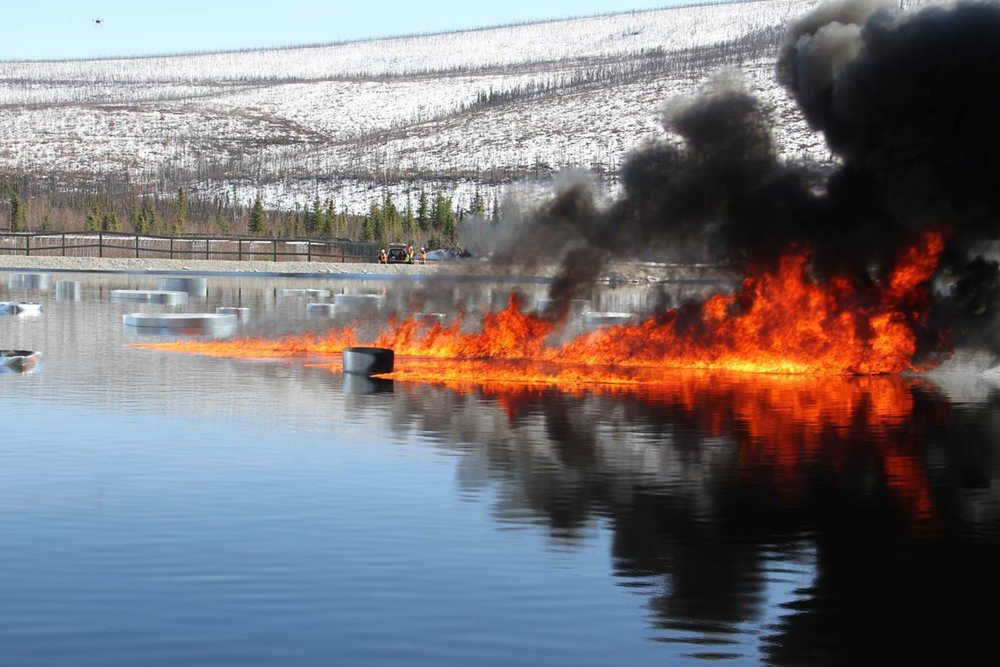On a clear day last spring, fire sizzled on water at Poker Flat Research Range in the Chatanika River valley.
There, scientists were spilling crude oil in a manmade water basin and torching it from above. A series of similar test burns were part of a team effort between university scientists and researchers with the oil and gas industry.
On that April day, an orange flame hissed on the surface of a body of water 300-feet square and six inches deep. Black smoke rose and drifted with the wind.
After a few minutes, the smoke faded from black to white to invisible. The fire burned itself out. An air horn sounded.
“That’s a long victory salute,” said Bill Schnabel, an engineer and interim director of the Institute of Northern Engineering at UAF. He is the main Alaska scientist on five test burns of oil at Poker Flat. Jessica Garron of the Alaska Satellite Facility invited me out to watch.
I once mucked around in a real oil spill. I worked on the beaches of Prince William Sound as an “oil recovery technician” after the Exxon Valdez hit Bligh Reef in 1989. There, we scrubbed rocks with diaper-like pads and blasted rocks with streams of cold water from hoses, trying to direct floating oil to skimmer boats. We gathered some, but most of it soaked into the beaches.
In the Poker Flat experimental burn, most of 50 gallons of North Slope crude vaporized in the fire. Peeking over the edge of the basin, I could see no more black on the water. All that remained was a patch of whitish, waxy residue the size of a dinner table. Oil-spill professionals here for the test dipped sample bottles to gather some of the white stuff. They handed them to a graduate student doing her Ph.D. research on the burns.
Backing up a bit, here’s the experiment from start to finish: Into the water, two professional oil-spill workers dumped 10 five-gallon buckets of crude oil obtained from a Trans-Alaska Pipeline System tap in North Pole. They spilled the oil into a metal ring about 15 feet in diameter. The ring contained the oil until one of them pulled a cable that lowered it into the water. As the ring submerged, the oil crept across the surface.
Other workers filled tanks on a helicopter with a liquid known as herding agent. Navy researchers in the 1970s developed the liquid to change the surface tension of the water. Floating oil often spreads too thin to overcome the heat-stealing capacity of water.
The helicopter pilot hovered over the basin and sprinkled herder from what looked like a showerhead attached to a long hose. The liquid forced the oil to clump together.
With the oil sticking together in the basin, the helicopter landed. Men in hard hats installed a torch used in firefighting to a set of cables dangling from the helicopter. The helitorch, which looks like something an Alaskan made in his garage, is a 55-gallon drum containing gelled fuel and a propane burner to ignite it.
Slinging the torch over the pond, the helicopter pilot hovered over the concentrated crude. He then dribbled a stream of flame onto the water. Bull’s-eye. The oil on the surface ignited. The people there, many of them working for what’s called the Arctic Oil Spill Response Technology Joint Industry Program, seemed to be happy with the result.
Burning oil at the site of an ocean spill is not a new idea. Officials executed it at the Deepwater Horizon spill of 2010. For varying reasons, that burn removed very little of the spilled oil. And even though the Poker Flat experiment was efficient (one expert on scene estimated that more than 90 percent of the 50 gallons was burned), no one there thought burning was the perfect answer.
Ian Buist of SL Ross Environmental Research of Ottawa, an expert on oil spill behavior and how to deal with it, said at Poker Flat that burning is not often feasible, especially if the response is not quick and oil has spread too far. In Alaska, researchers envision stationing unmanned aerial vehicles in likely spill areas to perform the tasks the helicopter executed at Poker Flat. Schnabel said the Poker Flat experiments helped answer one major question:
“Can we mobilize from the air and hit it from above? This way we don’t have to wait for a ship to get there.”
• Since the late 1970s, the University of Alaska Fairbanks’ Geophysical Institute has provided this column free in cooperation with the UAF research community. Ned Rozell is a science writer for the Geophysical Institute.

